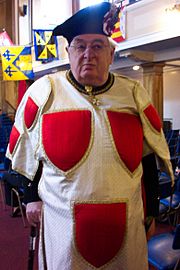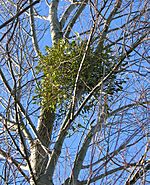Clan Hay facts for kids
Quick facts for kids Clan Hay |
|||
|---|---|---|---|
| Garadh, MacGaradh | |||
| Motto | Serva jugum ("Keep the yoke") | ||
| Slogan | "A Hay! A Hay!" | ||
| Profile | |||
| Plant badge | Mistletoe | ||
| Animal | Falcon | ||
| Chief | |||
 |
|||
| The Rt. Hon. Merlin Sereld Hay | |||
| The 24th Earl of Erroll | |||
| Seat | Woodbury Hall | ||
| Historic seat | New Slains Castle Old Slains Castle |
||
|
|||
|
|||
|
|||
Clan Hay is a famous Scottish clan from the Grampian region of Scotland. This clan has been very important in Scotland's history and politics for a long time. You can find members of Clan Hay all over Scotland and in many other parts of the world. However, the main area for the Hays is the North East of Scotland, including places like Aberdeenshire (historic) and Perthshire.
Contents
What Does "Hay" Mean?
The name "Hay" comes from several villages in Normandy, France, called La Haye. The word haye means "hedge" or "stockade" in old French. This part of Normandy is known for its old hedgerows. Over time, "de la Haye" became "Hay" in English. In Scottish Gaelic, it's sometimes called Garadh.
The Legend of Luncarty
There's a famous story about how Clan Hay began, called the Legend of Luncarty. It's an important tradition for the clan.
The story goes that around the year 980, Danish invaders were winning a battle near Perth. The Scottish army was running away. Suddenly, a farmer and his two sons appeared in a narrow path. The farmer stopped the fleeing Scots and told them it was better to fight bravely than to run. He grabbed his ploughshare (a part of a plough) and led the Scots back into battle, shouting that help was coming.
The Danes thought a new army had arrived and got confused, running away themselves. The Scots then won the battle!
The king, Kenneth III, was very grateful. He brought the farmer, who became known as Hay, and his sons to a special meeting. As a reward for their bravery, the king gave them a large piece of land along the river Tay. The land was as much as a falcon could fly over before landing. This turned out to be six miles long and was later called Errol.
To make them nobles, the king also gave them a special coat of arms. It showed three red shields on a silver background. This was to show that the father and his two sons were like "three fortunate shields" that protected Scotland.
Historians have looked into this legend. While some parts might be exaggerated, there is some evidence that a battle happened in that area. For example, old burial mounds were found with human remains and weapons, which could be from a battle. Also, local place names like "Redgorton" (meaning red fields, perhaps from blood) and "Turnagain Hillock" (where the Danes supposedly turned back) support the idea of a battle.
Clan History
Early Days: William II de Haya
The Clan Hay family came from a Norman family called de la Haye. The first Hay recorded in Scotland was William II de Haya. He was at the Scottish court around 1160. He served as a special helper to King Malcolm IV of Scotland and King William I of Scotland. King William I made him the first Baron of Erroll.
Family Ties to Normandy
Experts have found links showing that the Scottish Hays are related to the de La Haye family in Normandy, France. This link is based on their family heraldry (the designs on their shields). A seal used by David de Haya (William II's son) around 1230 shows three small red shields on a silver background. These are the same designs used by a French family, Jean de La Haye-Hue, in Normandy much later. This suggests they were from the same family.
Important Hays Through Time
After William II de Haya, his son David took over. David's son, Gilbert, became the Sheriff of Perth and a guardian for King Alexander III.
Fighting for Scotland's Freedom
Gilbert's son, Nicolas de Haya, was also Sheriff of Perth. His son, Gilbert de Haye of Erroll, played a huge part in the Wars of Scottish Independence. At first, he swore loyalty to King Edward I of England. But in 1306, he joined Robert the Bruce and stayed loyal to him throughout the war.
Gilbert de Haye fought bravely with Robert the Bruce at the famous Battle of Bannockburn in 1314, where the Scots won a great victory. Because of his loyalty, Robert the Bruce gave him land in Aberdeenshire and made him the Lord High Constable of Scotland, a very important position. Gilbert de la Hay also signed the Declaration of Arbroath in 1320, which declared Scotland's independence.
16th Century Battles
The Clan Hay faced many losses during the Anglo-Scottish Wars. In 1513, many Hays died at the Battle of Flodden. Another Hay, Sir Gilbert, even fought alongside Joan of Arc in France during the Hundred Years' War.
After the Scottish Reformation, when Scotland changed its main religion, the Hays remained Catholic. This made them allies of Mary, Queen of Scots. Later, Francis Hay, 9th Earl of Erroll, was part of a plan with the King of Spain to try and make Britain Catholic again. But this plan failed after the Spanish Armada was defeated. In 1594, the Earl of Erroll had to leave Scotland, and Old Slains Castle, the family home, was blown up by the king's orders. It has been a ruin ever since.
Civil War and Jacobite Risings
During the Civil War in the 1600s, James Hay led his forces as Royalists (supporters of the King) and won the Battle of Aberdeen in 1644.
Later, in the 1700s, after Scotland and England joined to form Great Britain, the Hays were sympathetic to the Jacobite cause. This meant they supported the return of the Stuart kings to the throne. The 13th Earl of Erroll even received a special award from James Francis Edward Stuart, who was known as the Old Pretender. His sister, Mary, later used the ruins of Old Slains Castle as a secret meeting place for Jacobite agents. She personally called on Clan Hay to fight for Charles Edward Stuart (Bonnie Prince Charlie).
After the Jacobite cause failed, the Hays became loyal British subjects. Many Hays then helped expand the British Empire around the world.
Clan Profile
- Gaelic Names: MacGaraidh (Surname) & Clann 'icGaraidh (Collective)
- Motto: Serva Jugum (Keep the yoke)
- Slogan: "A Hay! A Hay! A Hay!"
- Clan Hay Society: The Official website of The Clan Hay: http://www.clanhay.org/
- Pipe Music: "A Hay - From A Hay To Delgatie Castle" and "Stand Up Scotland"
- Pipe Band: Clan Hay Pipe Band Pipe Major: Philippe Vervoort
- Pipe Band Facebook Page: FB Clan Hay Pipe Band
- Crest: A falcon flying, coming out of a special crown.
- Clan badge: Mistletoe
- Animal Symbol: Falcon
- Chief's Arms: A silver shield with three red shields inside.
Clan Chief
The current chief of Clan Hay is Merlin Sereld Victor Gilbert Hay. He is the 24th Earl of Erroll and the official head of the Hay family.
Castles of Clan Hay
The Clan Hay has owned many impressive castles throughout history:
- Delgatie Castle, Aberdeen, Scotland: Given to the clan after the Battle of Bannockburn in 1314.
- Slains Castle: Owned by the chiefs of Clan Hay from 1597 to 1916.
- Old Slains Castle, Aberdeenshire, Scotland.
- New Slains Castle, Aberdeenshire, Scotland.
- Dupplin Castle, Perth, Scotland
- Duns Castle, Berwickshire, Scotland
- Inshoch Castle, Nairnshire, Scotland
- Megginch Castle, Perth, Scotland
- Neidpath Castle, Peebles, Scotland
- Park Castle, Galloway, Scotland
- Yester Castle, East Lothian, Scotland
Family Coats of Arms

Here are some of the different coats of arms used by various branches of the Hay family:
|
of Erroll |
of Leys |
of Seafield |
of Fudie |
of Cardenie |
|||||
|
of Urie |
of Alderston |
of Dalgety |
of Megginch |
of Leith |
|||||
|
of Park |
of Naughton |
of Strowie |
of Pitfour |
of Newhall |
|||||
|
of Laxfirth |
of Letham |
||||||||
|
of Boyne |
of Locherworth |
of Broxmouth |
|||||||
|
of Tweeddale |
of Yester |
of Linplum |
of Smithfleld and Haystoun |
||||||
|
of Kinnoull |
|
||||||||
|
of Leys |
of Pitfour |
of Seggieden |
|||||||
|
|
of Errol |
of Tweeddale |
Clan Tartans
Tartans are special patterned fabrics that represent different Scottish clans. Here are some of the tartans associated with Clan Hay:
See also








































